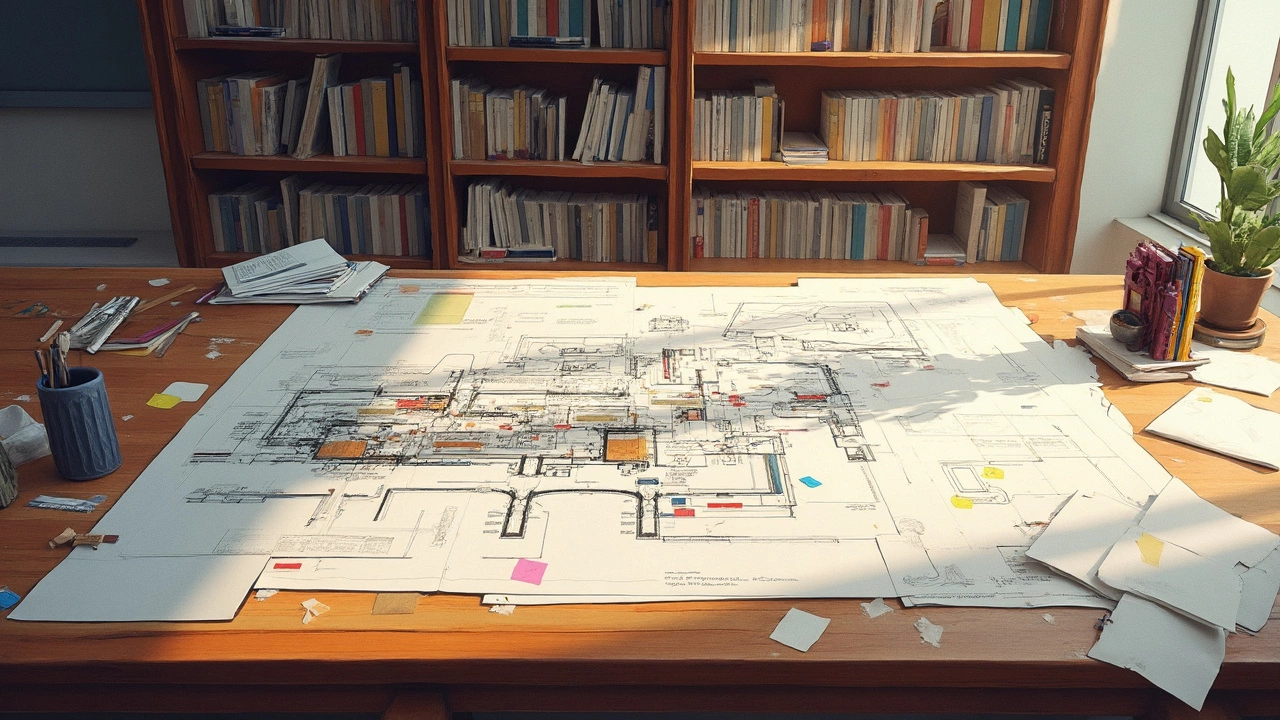So, you're thinking about kicking off a construction or renovation project. It might surprise you to know that one of the first and most crucial steps is nailing down a solid brief for architectural services. But why does this seemingly simple document carry so much weight? Well, it’s basically the roadmap for everybody involved.
Imagine trying to build a house without knowing how many rooms it needs or what vibe you’re going for. That'd be chaos, right? A good brief helps you avoid that mess by clearly laying out what's expected. This means not just the number of rooms but diving deep into needs, preferences, and those little dream features you've been Pinterest pinning.
In some ways, crafting a brief is a bit like detective work. It involves chatting with clients, understanding their lifestyle, and figuring out the nitty-gritty details like the budget and timeline. By getting these elements right from the start, you set the stage for a project that’s both on-time and on-budget. Plus, it makes life way easier for your architects and designers, letting them unleash their creativity without second-guessing the basics.
- Why a Brief Matters
- What's in a Good Brief
- Gathering Client Insights
- Setting Clear Objectives
- Budget and Timeline Considerations
- Tips for Crafting Effective Briefs
Why a Brief Matters
Let’s get one thing straight—without a good brief, even the most talented architect might find themselves a bit like a ship without a compass. Why? Because a well-structured brief for architectural services sets the tone and direction for the entire project. Think of it as the DNA of your project. It carries all the critical info needed to turn your dream into bricks and mortar.
Imagine throwing a lavish dinner without knowing who’s coming or what they like to eat—it’d be a recipe for disaster. Similarly, an architectural brief tells the architect who the 'guests' are (that’s you and your team) and what they expect. It includes details like preferred styles, specific needs, and possibly even some inspiration from your favorite buildings.
Beyond personal preferences, practicalities can't be overlooked either. The brief tackles important aspects like budget constraints and deadlines, which helps architects plan realistically. Budget and timeline considerations ensure everyone is on the same page, reducing misunderstandings and ensuring the resources are allocated wisely.
Did you know? Studies show that projects that start with a comprehensive brief are more likely to be completed on time and stay within budget. This is because everyone involved, from designers to contractors, knows what they’re working towards.
So, a good brief isn't just a nice-to-have. It's essential. It streamlines communication, aligns goals, and, most importantly, keeps those construction or renovation headaches at bay. That’s why a well-crafted architectural brief is worth every minute you spend on it.
What's in a Good Brief
Creating a standout brief for architectural services isn't just about jotting down a few bullet points—it's about detail, clarity, and vision. So, what exactly does a good brief include? Let's break it down.
First off, any solid brief starts with understanding the client's goals. What are they hoping to achieve with the project? Are they dreaming of a modern family home, a sleek office space, or maybe an eco-friendly retreat? This is the foundation on which everything else is built. Without knowing this, it’s like trying to solve a puzzle without all the pieces.
Next, you'll want to dive into specifics like dimensions and layout needs. Here, it's crucial to capture everything from room numbers and sizes to more precise details like storage space and lighting. Don't forget about style preferences—whether it's minimalistic, rustic, or something in between. Getting these elements right ensures that design plans align perfectly with the vision.
Budget and timeline are also key players in a good brief. Clearly stating the financial range and when the project's expected to be completed is essential. It not only keeps the design within pragmatic bounds but also helps avoid surprises later on.
Finally, the brief should include any legal or site-specific requirements. This might involve zoning laws, accessibility standards, or unique environmental concerns that need addressing. Overlooking these could cause delays or even legal issues, so they're crucial components.
Here’s a simple checklist for crafting a strong brief:
- Client Goals: What’s the big picture?
- Design Details: Size, space, and style preferences.
- Budget and Timeline: Feasible numbers and realistic deadlines.
- Legal Requirements: Any special regulations or needs.
Remember, the aim of the brief is to communicate. Every element should contribute to creating a shared understanding between the client and the architect—a partnership that brings the project to life seamlessly.
Gathering Client Insights
When it comes to putting together a rock-solid brief, diving into the client's world is a game-changer. It might sound a bit like therapy, but getting to know what makes a client tick is super crucial for architectural services. Without these core insights, designers might end up guessing, which is a surefire way to miss the mark.
So, where do you start? Open, honest conversations are your best friend here. Begin by asking the client about their lifestyle, daily routines, and what they value most in their space. Maybe they love entertaining and need lots of open areas or perhaps they're after a serene retreat from the hustle of daily life. These little personal details are the secret sauce that helps shape exceptional designs.
During discussions, it's not a bad idea to have a checklist handy. Here’s a quick rundown of some must-ask questions:
- What are the primary functions of the space you envision?
- Do you have any specific design preferences or inspirations?
- What are your must-haves and deal-breakers in the project?
- Are there any future plans that might affect the space, like family expansion or working from home?
Once you've gathered that intel, documenting it clearly is key. It not only sets expectations but also saves a ton of time later on when those pesky doubts start cropping up. Being thorough at this stage helps keep everyone on the same wavelength and minimizes surprises down the line.
Visualization tools can be a lifesaver too. Mood boards, sketches, or even a quick Pinterest board can help solidify what's floating around in the client’s mind. In fact, a study found that using visuals in the briefing process can enhance client satisfaction by up to 40%. That’s no small number!
Overall, it’s like piecing together a puzzle. Each answer from your client edges you closer to the masterpiece: a tailored design that makes the client’s day-to-day life better in a thousand little ways. When everyone speaks the same language from the get-go, it makes the rest of the architectural journey a breeze.

Setting Clear Objectives
Alright, now let's talk about why setting clear objectives is like the secret sauce in your architectural project recipe. Whether you're planning a skyscraper or a cozy home, having clear objectives ensures everyone is on the same page. Think about it this way: if you don't know where you're going, how will you get there?
First, identify the main purpose of the project. Is it for retail, residential, or maybe something funky like a mixed-use building? This primary use influences design decisions from the get-go. Write this down in the brief, so the architects and designers can tailor their ideas right from the start.
Next up, consider the aesthetics and functionality. Are you going for a minimalistic modern look or something more traditional? Jotting down these preferences helps guide architects in blending style with practicality. Remember, it's not just about looking pretty; functionality ensures the space works for its intended use.
Also, think about the project's impact past the pretty walls. Are there sustainability goals? Maybe you’re aiming to reduce energy consumption or incorporate renewable materials. Setting these objectives early can steer the project toward greener solutions.
Lastly, if there are community or historical considerations, make sure they're in the brief. It’s about respecting the neighborhood vibe or preserving a bit of history while injecting fresh design ideas.
To sum it up, setting clear objectives helps keep the project focused, preventing the dreaded scope creep where things get chaotic and off-target. Plus, it builds a strong foundation for collaboration between you and your architectural services team.
Budget and Timeline Considerations
When it comes to architectural services, getting a grip on the budget and timeline is a huge deal. These aren't just numbers on a spreadsheet—they're the backbone of your project. Before you even get started, you need to have a clear idea of how much you're willing to spend and how long you can wait for the project to be completed.
First things first, a realistic budget ensures that the project is financially feasible. It helps keep you from dreaming so big that your wallet can’t keep up. To make it work, you should consider not just construction costs but also the fees for permits, approvals, and, of course, the architect's fees themselves. It's like building a puzzle, and each piece must fit well to see that final picture.
What about timelines? Well, they’re just as important as the budget. Everyone wants things done yesterday, but rushing can lead to cutting corners and missing details. A well-planned timeline sets expectations for each phase of work, allowing for the unexpected hiccups that come with every project.
Here’s a little pro tip: always add a buffer to both your budget and timeline. Think of it as your safety net for those inevitable surprises, like material delays or unanticipated structural issues.
To give you an idea of how these elements stack up, here’s a quick breakdown:
| Consideration | Tip |
|---|---|
| Construction Costs | Include a 10-15% contingency fund in your budget. |
| Project Timeline | Add an extra 20% to your timeline for unforeseen delays. |
| Permits & Approvals | Research local regulations early to avoid setbacks. |
By keeping these factors in mind and discussing them early with your architect, you’re setting up your project for success from the start. Remember, thorough planning in these areas can save you a lot of stress down the road.
Tips for Crafting Effective Briefs
Creating a rock-solid brief for architectural services is like setting up the ultimate game plan. It’s going to guide the architects and help you get exactly what you’re dreaming of. Here's how you do it right.
First off, always get to know your client. Have a casual chat or even a series of conversations to really dig into what they want. Sometimes, they might not know exactly what they need, but by asking about their day-to-day, you can help form the vision.
Next, keep things clear and specific. Nobody likes guesswork when it comes to building stuff. Clearly outline the number of floors, types of rooms, and any special features. Remember, the more precise the details, the less room there is for misunderstandings later.
Budget is a biggie. Always discuss and agree upon it early in the process. Having a realistic budget is crucial to keeping expectations in check and avoiding nasty surprises halfway through the project.
Here are a few actionable tips:
- Visual References: Encourage the use of mood boards or digital tools where clients can share their style preferences easily.
- Site Analysis: Don’t forget about the site where the building will stand. Consider aspects like sunlight, wind patterns, and topography.
- Timeline Clarity: Set clear milestones for project phases. Everyone should know when to expect the big reveals and what’s coming next.
It’s also smart to include a section on any regulatory or zoning considerations from the get-go. This helps avoid red tape hiccups later on. And when possible, use past project examples to visualize how certain ideas turned out. It can be a real eye-opener for clients.
By following these tips, you'll find that not only does the project flow better, but everyone involved has a smoother and, let's be honest, more enjoyable time bringing the vision to life.
